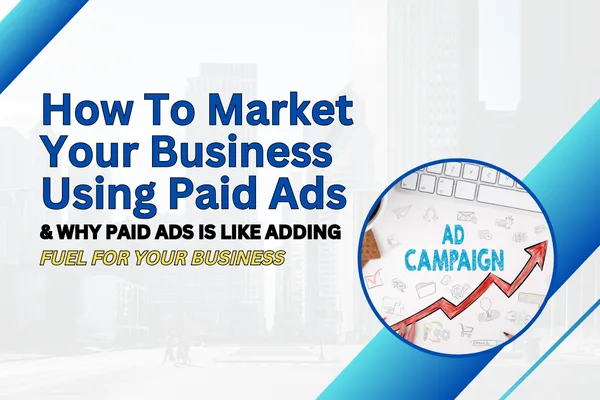Receive Weekly Revenue Boosting & Life Improving Tips, Tricks & Secrets All For FREE
We'll Do The Hard Work & Find More Ways To Make You Money - Just Sit Back, Relax, & Enjoy Reading Our Specially Focused Blogs For Small Business Owners
We'll never share your info with anyone.

How To Market Your Business Using Paid Ads
Introduction
Paid advertising is kind of a controversial topic in marketing. With paid ads, there are two types of people. The first group is EXTREMELY successful and can see results like $10 for every $1 spent. They essentially use ads as a money-printing machine. However, the vast majority of people usually just lose money and never use paid ads again.
So, what's the difference between the two types? I'll tell you.
The first group has a strategy, a framework, and a lot of past failures that they've learned from. This group of people have either spent a lot of money and time learning how to run paid ads from another person, or they've spent even more money and time failing at paid ads until they FINALLY got it right.
The other group is usually just guessing. Maybe they've watched a few YouTube videos, read a few books, or learned from their friend. These people usually have no plan or framework. Unfortunately, these people end up wasting their time and money on ads that never convert.
In this blog, you'll learn the exact 7 steps that I go through in order to successfully advertise online with paid ads. This will make you be much more likely to belong to the first group, rather than the second.
How to Measure ROI For an Advertising Campaign
Return on Ad Spend (ROAS)
The simplest way to measure the ROI of an advertising campaign is by using the Return on Ad Spend (ROAS). To calculate this metric, you divide the revenue earned from the ad campaign by the amount that was spent on the campaign.
ROAS = Revenue Earned / Ad Spend
For example, if you spend $1,000 on an ad campaign and made $10,000, then your ROAS would be 10 or 1000%.
ROAS = $10,000 / $1,000 = 10
This metric basically gives you a good summary of how well your ad campaign translated to actual revenue. The higher the ROAS, the better your ad campaign.
Click-Through Rate (CTR)
This metric measures how often people are actually clicking on your ads. To find the CTR, simply divide the number of clicks by the total number of impressions (which is the number of times your ad was seen).
CTR = Clicks / Impressions
For example, if an ad received 10,000 impressions and 1,000 clicks then your CTR would be 10%
CTR = 1,000 / 10,000
A high CTR generally means that your ad copy was effective and made people want to see what was next. A high CTR is very important because it can impact your ad rank and its quality score. In order to increase this metric, make sure your ad copy is strong, and it gives the prospect a reason to take action right now.
Now that we went over a couple of important metrics for measuring ad campaigns, let's look at how you can develop you own framework for creating winning ad campaigns.

Your 7 Step Plan to Maximize ROI from Online Advertising
Step 1: REVIEW Successes and Failures
In online advertising, failure is inevitable. Don't expect to go through the gauntlet of paid ads unscathed. In fact, failing at paid ads is actually part of the process. You want to use what hasn't worked in the past, change it up, and see if the new variation works.
Nevertheless, you need to ask yourself a few questions like:
What ad platform has produced the most (if any) revenue?
Which ads (if any) have gotten the best results?
Which ads (if any) have gotten the worst results?
Creating online ads and becoming good at them requires A LOT of trial and error. You've got two options, go through the pain of making all the errors yourself OR hire someone who's already made the errors and knows how to actually hit the target. (hint, hint ;) )
Step 2: RESEARCH Audience and Competitors
Finding the right audience is one of the most important aspects of a winning ad campaign. You can have the best copy, the best creatives, the best landing pages, the best offer, and the best fulfillment, and none of it will matter if the audience is all wrong.
Think about it, imagine you sell things to single moms and the ad goes out to a polygamous grandpa. Obviously, the example is a little extreme but even slight variations in audience targeting can be the difference between a massive ROI and losing every penny you spent.
Write down all the demographics, interests, and other characteristics of your customers. Ask yourself things like:
What other business pages or groups are my customers in?
What other companies do my customers follow?
What life events are my audience experiencing?
Now, you need to see what your competitors are doing to target your audience. To do this, you can go to any Facebook Business Page and look at "Page Transparency", now click "See All", then "Go to Ad Library". Here, you find all the Facebook ads your competitors are currently running.
If the ads have been running for a long time, chances are they're making your competitors money. Learn from these ads and use the tactics in your own ad campaign.
Step 3: STRATEGIZE Mission and Messaging
Now you need to communicate your brand identity and mission. Your messaging is what you audience will receive when they see your ads, and your mission is what you want them to feel.
With each ad message, you want your customers to understand what you're about. This helps separate you in a crowded marketplace. For this, you need to know what the purpose of your business is, what your core values are, and what makes you different from every other related business.
Having effective messaging will increase the chances that somebody will click on your ad. Take time to figure this part out, it will pay off handsomely when done correctly.
Step 4: GAMEPLAN Metrics and Planning
The next step is identifying the goals you have for your ad campaign and creating a plan to get there. 9 times out of 10, the goal of an ad campaign is to increase sales. However, there are many other stats that you can monitor in order to ensure that you are well on your way of achieving the goals you set out for yourself.
These stats have to lead to sales either directly or indirectly and need to be an indicator for decision making. Some of these stats will come directly from the ad campaigns that you are running and other may come from business results that your ad activity helped produce.
Earlier in the blog we discussed a couple very important metrics to keep an eye out for, but some other examples can include:
Cost Per Conversion
Impressions
Direct Sales from Ads
Coupon Code Redemptions
When first launching a new ad campaign, you want to give it about a week to have enough time to generate accurate and meaningful data. Give your ad campaigns time to do their job.
Step 5: TEST Creative and Distribute
The actual ad copy (the words that are used in your ad) and the creative (the actual graphics that you're creating) need to be compelling. For many people your ad will be the first time they ever come across your business.
For this reason, you need to make sure that your first impression is something that will stick in their minds. You need to test all the ingredients of your ad so that it converts at the highest rate possible. Doing this is the best way to develop an understanding of what your audience actually wants from you.
Here are some of the things that you should be testing:
Creative - the main image or video
Headline - the immediate "hook" of the ad
Copy - the text that follows the headline
Call to Action (CTA) Button - the button people click to be redirected somewhere else
You need to make sure that your ads and landing page are congruent and seamless. Your ads need to be created with the end goal in mind. Think about the action you want the person to take then create an ad that gets them there.
Step 6: OPTIMIZE Performance and Data
Always be on the lookout for ways that you can optimize your ads. In this step, you want to use the results from your tests to pick winning headlines, copy, creatives, etc. to move forward with. Once you do this, test that winning ingredient against another version.
Your traffic is wasted if you're not testing something and making improvements based off the results from the tests you conducted. By constantly optimizing your ads, you will ensure that you are getting the most out of every dollar spent.
Step 7: SCALE Maximize & Profit
Now you need to track the ad metrics you've highlighted and make data-backed decisions. The data will help you to decide when you should crank up the ad spend or cut off a losing campaign.
Let the data guide your actions, never act out of emotion. If there's a loser, cut if off immediately. Focus most of your attention perfecting the winning ads.
Having a few losers is completely normal. Don't give up. All you need is one winner to completely change your business. Once you find that one winning ad, don't be afraid to spend some money. You should scale the winning ad up as much as 10-15% per day.
Conclusion
I hope you feel a bit more comfortable creating your own ad campaigns now. Since I wanted to keep this blog relatively short, I couldn't include my full 7-Step Plan to Profit with Online Ads. But you can click here to access it. In it, you'll find a much more detailed breakdown of what I just briefly went over.
When you click on the link, you'll be prompted to enter you email address. You'll then be sent the 7-Step Plan AND a "How It Works" video AND an opportunity to book your own 100% free 30-minute strategy call where I'll personally make you a 7-Step Plan for your own business.
Again, all of this is 100% free and you'll leave with a solid framework of how you can create online ads for your own business.
Remember, ONE WINNING AD CAMPAIGN CAN COMPLETELY CHANGE YOUR BUSINESS
In this blog, I barely scratched the surface of how to create winning ads for your own business. If you haven't already, click here and enter your email if you want to receive weekly free blogs with valuable information just like this.
Next week, I'll talk about multiple ways you can bring attention to your business to attract more leads, convert them into customers, and increase customer retention and lifetime value.
For more free tips, tricks, and secrets, click here to follow us on Instagram, and click here to follow us on Facebook.
Contact Us:
Email: [email protected]
Phone: 855-960-5019
Copyright Pivotalix 2023 -- All Rights Reserved
We’re on a mission to build a better future where technology creates good jobs for everyone.
